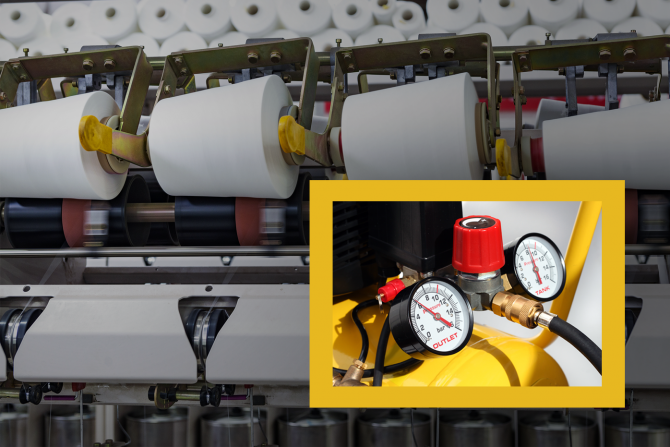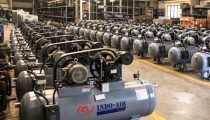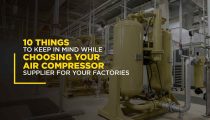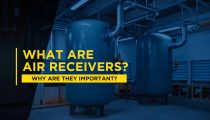Uncontrolled losses draining away a whopping 20 percent of your…

How to achieve higher textile production by increasing compressor efficiency?
Compressed air is necessary to carry out industrial operations as it is considered one of the significant utility services. In the textile industry, compressed air plays a key role in both man-made and natural textile production. Both directly and indirectly, the profit margin of the business is dependent on compressed air systems and its efficiency. An air compressor system must run on its optimum efficiency for executing business operations seamlessly.
A compressor’s efficiency can be maintained, increased and it lasts long with routine servicing. Choosing the right type, professional installation and with proper handling techniques Its efficiency can be increased in favour of cost effective production.
The guidelines to achieve higher productivity in textile industry are as follows:
Choosing the right compressor
With right selection comes greater production. A compressor system must be chosen based on a factory’s production requirements and capacity. Preliminary research is very important before investing on a good and suitable compressor.
Basically, manufacturers get to choose from two types of compressors based on their construction & operation. Firstly, the Positive Displacement Type which includes reciprocator and rotary compressors. Secondly, the Dynamic Type includes centrifugal and axial flow compressors.
For robust and reliable services non-lubricated compressors ensure delivery of high quality air. While, lubricated compressors help in dissipating heat and maintain its efficiency level. With lower operating efficiencies at part load if unload power remains high; efficiency can be affected highly. However, installing a VFD (variable frequency drive) or HPM motor (hybrid permanent magnet; as in the compressor system would make these efficient throughout the varied operating range.
With a payback period of 2 years mostly, centrifugal compressors can also be considered as it is 10-15% more efficient and has lower maintenance costs. Features like 100% oil-free air, continuous pressure, high turndown capacity with efficient part-load and zero chances of wear and tear, maintenance costs can be much lower. These are available from 250 hp to 5,000 hp and upward as well.
Improving system design
Efficiency can be increased by improving the design of the system as well. It is necessary to choose a professionally designed system where smooth and non-corroding materials have been used. Pipelines made of such materials help in pressure delivery and airflow.
The bends and angles on the path of air must be at minimum as the straight path tends to save more energy. Further, installing a heat recovery system will help recover all the energy that is lost as heat. Keeping multiple small compressors in stock for heavy workload is ideal as it helps in avoiding strain on a single unit.
Proper Compressor Controls
Operators must have proper training or guidelines to understand how to control a system for increasing their efficiency. Operating at a maximum pressure is not good for the compressor system every time. Understanding the requirements and capacity the are primary steps before setting up the compressor.
Understanding the system needs
High efficiency can be achieved with proper understanding of a system’s real needs. To begin with, assessing demands would be really helpful. If the number of devices and the energy demands can be calculated, understanding maximum pressure loads for each device would not be difficult to estimate. Operating only at a required pressure would help these run for a longer time efficiently.
For instance, it does not make sense if the device needs 60psi and the compressor is providing 100psi to power it. Taking up extra air uses a lot of energy which is not at all desired.
Eliminating pressure drops
All pipelines must be of appropriate sizes which make them handle maximum flow rates. To avoid issues with pressure drops, the air should be moisture free and filtered out as well.
Go for equipment like filters, lubricators and after coolers which come with the guarantee of lower pressure drops. Design system in a way where air has to travel a short distance before fulfilling its purpose.
Regular maintenance is mandatory
Regular maintenance is the most effective way to ensure efficiency. Filters must be changed and cleaned while the rest of the equipment and controls must be tuned as well. Leak detection is mandatory. Even the tiniest leak can damage the entire system creating a large power loss during the ongoing operations.
Compressor’s efficiency is the fuel to production
Efficiency of an air compressor depends on various aspects which include: suitable material acquisition, mechanical and electrical services from the experts, a complete set up of the system, regular maintenance of the system and the accessories attached to it. Additionally, following preventive guidelines are equally important. With the right maintenance and handling, an air compressor can last up to ten years or more. All the above mentioned factors, if taken care of properly, ensures efficiency and helps in higher production in the textile industry.





I don’t think the title of your article matches the content lol. Just kidding, mainly because I had some doubts after reading the article.
The point of view of your article has taught me a lot, and I already know how to improve the paper on gate.oi, thank you.
Thank you for your sharing. I am worried that I lack creative ideas. It is your article that makes me full of hope. Thank you. But, I have a question, can you help me?